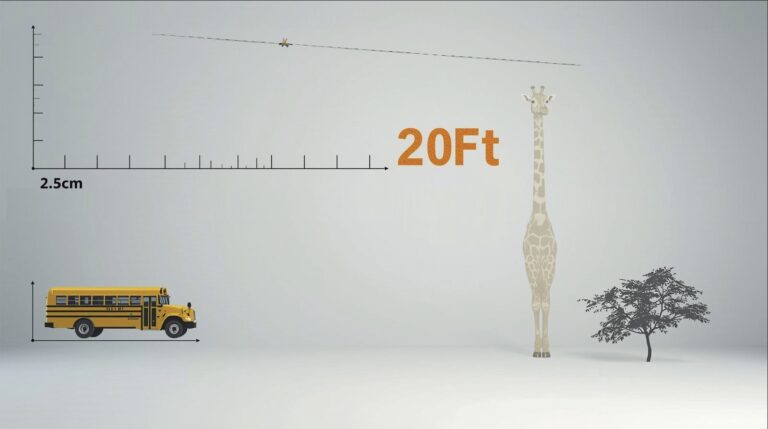Things That Are About 200 Feet Long: A Detailed Exploration

When we think about distances and lengths, some measurements can be difficult to visualize.
However, 200 feet is a familiar benchmark that appears in various contexts—architecture, nature, transportation, and more.
This article will discuss the Things That Are About 200 Feet Long, providing detailed examples and insights into each.
1. Bowling Alleys
Overview
A standard bowling lane measures 60 feet long from the foul line to the pins. However, when you consider the approach area, which typically extends about 15 feet before the foul line, the total length comes to around 75 feet. The full setup for a bowling alley, including multiple lanes, approaches, and seating areas, can stretch out to around 200 feet in total length.
Example
In a modern bowling center, ten lanes, each approximately 4 feet wide, can combine with the seating and approach areas to create a layout that approximates 200 feet in length. This design maximizes space while providing a recreational area for multiple players.
Importance
Bowling alleys are not just venues for sport; they serve as social hubs where friends and families gather, making the spatial layout essential for a pleasant experience.
Source: Bowling Alley
2. Container Ships
Overview
Container ships have transformed global trade by carrying large quantities of goods across oceans. While the length of container ships varies significantly, many fall into the category of approximately 200 feet long.

Example
The typical feeder ship, used for transporting containers to smaller ports, measures around 200 feet. For instance, the MOL Majesty is a well-known feeder vessel designed for short-distance shipping, fitting snugly into this category.
Importance
The dimensions of container ships helps in comprehending the logistics of maritime trade, illustrating the scale at which global commerce operates.
Source: Container Ship
3. Baseball Fields
Overview
A standard baseball field features dimensions that can be challenging to visualize. The distance from home plate to the outfield fence varies, but a common dimension for a typical major league field is about 400 feet to center field. However, if we consider the length from home plate to first base and the width of the infield, the entire setup can approximate 200 feet in total length.
Example
In a youth baseball league, the distance from home plate to first base is 90 feet. If we expand this to consider the infield and other dimensions, the overall area used for play and spectator seating can reach around 200 feet.
Importance
Baseball fields are a central part of American culture, where community and sports converge, making their dimensions significant in recreational planning.
Source: Baseball Field
4. Fire Trucks
Overview
While the fire truck itself isn’t 200 feet long, the total length of a fire truck and its attached equipment, like hoses and ladders, can be around this distance when fully extended during operations.
Example
A typical ladder truck might have an extendable ladder that can reach upwards of 100 feet in length. When factoring in the truck’s length and the hoses deployed during an emergency, the total working area can easily extend to around 200 feet.
Importance
Fire trucks represent critical emergency services, and understanding their dimensions and capabilities can enhance our appreciation of their role in public safety.
Source: Fire Engine
5. Ski Resort Runs
Overview
Ski resorts often measure their runs in feet. A single run can vary greatly in length, but many intermediate runs hover around 200 feet, providing a fun yet manageable experience for skiers.
Example
At a ski resort like Aspen, Colorado, one of the shorter intermediate runs, such as the “Silver Queen,” measures approximately 200 feet. These runs offer the thrill of skiing without the intimidation of longer trails.
Importance
Ski runs are designed to cater to different skill levels, and understanding their lengths helps in planning a day on the slopes.
Source: Ski Resort
6. High School Tracks
Overview
An outdoor high school running track is typically oval-shaped, with a standard lap length of 400 meters (approximately 1,312 feet). However, each straight section of the track can be around 200 feet long.
Example
Consider a typical high school track; the straightaways, usually about 100 meters long, can represent distances that are critical for sprint events, allowing athletes to compete effectively.
Importance
Tracks serve as essential training grounds for athletes and are integral to school sports, highlighting the importance of accurate measurements in athletics.
Source: Track and Field
7. Elevators in Skyscrapers
Overview
Modern skyscrapers often feature elevators that can travel vast distances. While the elevator shaft itself may not measure 200 feet, the distance covered when an elevator moves between floors can approximate this length, especially in high-rise buildings.
Example
Consider a skyscraper with each floor about 10 feet high; an elevator traveling between the 1st and 20th floors covers about 200 feet. This distance exemplifies the efficiency of vertical transportation in urban environments.
Importance
Elevators are vital for accessibility in tall buildings, and understanding their dimensions is essential for effective building design.
Source: Elevator
8. Football Fields
Overview
A standard American football field measures 100 yards (300 feet) long between the end zones, which is often simplified to 200 feet in terms of play area from goal line to goal line.
Example
A typical college football field, such as the one at the University of Michigan, has a total length of 120 yards including the end zones. The playing area itself, used primarily for gameplay, is 200 feet long.
Importance
Football fields are a cornerstone of American sports culture, and their dimensions are crucial for game design and player safety.
Source: American Football Field
9. Amusement Park Rides
Overview
Many amusement park rides, especially roller coasters, can have elements that measure around 200 feet in length.
Example
The “Fury 325” at Carowinds, while the tallest coaster reaches over 300 feet, includes sections of track that are approximately 200 feet long. These rides are designed to thrill riders with fast speeds and high drops.
Importance
Amusement parks are a staple of entertainment, and understanding the engineering behind these rides adds to the enjoyment and safety considerations for visitors.
Source: Roller Coaster
Conclusion
The measurement of 200 feet is significant across various domains, from recreational spaces to critical infrastructure. Whether it’s the fun of bowling, the excitement of baseball, or the essential services provided by fire trucks, these dimensions play a crucial role in our everyday lives. Understanding these contexts allows us to appreciate the scale and design of the environments we interact with regularly.
As we navigate our world, recognizing these familiar lengths can enhance our understanding and enjoyment of the spaces we inhabit, whether in sports, recreation, or urban life.
Feel free to let me know if you need any more details or additional topics!






